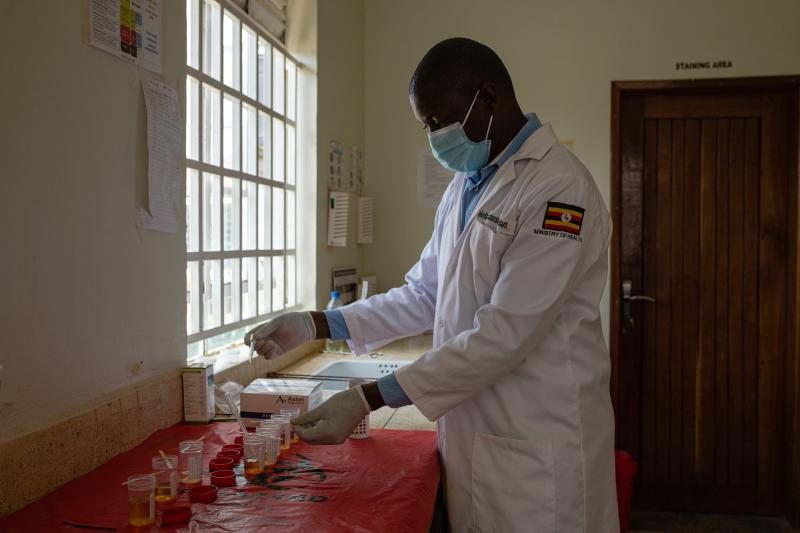Where We Work
See our interactive map


A lab technician at work at Nakaloke Health Center III in Mbale, Uganda. Photo by Esther Ruth Mbabazi for IntraHealth International.
How the US can build a global health workforce plan that’s effective and sustainable.
As the White House plans to launch a new initiative to strengthen the global health workforce around the world, I sat down with Cheick Touré, a doctor and health workforce expert from Mali who serves as IntraHealth International’s interim chief technical officer.
We talked about what the Biden Administration should incorporate into their plan to help build a stronger, more prepared, and more sustainable health workforce in Africa.
CT: If I were designing the White House initiative, I would focus on helping countries create a clear vision to strengthen entire health systems sustainably. That means focusing not just on the vertical programs that target one area for change but helping national governments with the tools and systems they need to measure the capabilities of their health workforce.
It's difficult, but it will last longer and lead to better results.
For example, in the early days of the Global Fund they only focused on malaria, tuberculosis, and HIV. But they saw that what they had achieved in those areas was fragile and when the project ended, everything went back to the same level or worse.
Now they emphasize integrated, people-centered services, building systems that protect people from multiple pathogens, address their holistic needs, and underpin health and well-being for all.
IntraHealth wants health workers to be present, ready, connected, and safe.
IntraHealth has clear goals for the workforce. We want health workers to be present, ready, connected, and safe. I think if donors like the US could make a strong investment in this approach, it will create a real difference.
CT: These four goals should be the entry points for a White House initiative for the health workforce. They would lead to better outcomes for all programs and be very useful for COVID-19 response and preparing for the next pandemic.
“Present” means health workers on the job where they are needed most. In Mali we have only six health workers for every 10,000 people (the World Health Organization recommends at least 23). Bamako, Mali’s capital, has the right numbers, but our rural areas have only two or three per 10,000. This is typical in West Africa.
So we need to help the ministry of health see where they need more health workers. Then they can establish a rotation of health workers from urban areas to rural or create schools close to the rural areas from which they can recruit new workers. They can also rely on community health workers to help in rural areas.
“Ready” means health workers are properly trained. They must have the right tools and data to do the job and an enabling environment to perform well in their jobs.
“Connected” refers to the digital solutions to make health workers’ jobs easier, like electronic medical records. These improve quality of care because if a client goes to another health center, we can transfer their medical records.
Digital solution can also help health workers on the job when they need to make decisions, check standards of care, or follow specific protocols. We can provide guidance in a digital format and even provide peer support to health workers.
“Safe” means exactly that: keeping health workers safe. We have seen a lot of health workers die due to COVID-19 and Ebola. These were new diseases, so health workers weren’t prepared to fight them. Safety also has a gender aspect, keeping health workers safe from gender-based discrimination.
And we must not forget the conflict zones in Africa. There is tension in a lot of countries where health workers aren’t protected from attack.
CT: If I were designing the White House approach, I would support a regional approach that standardizes tools, lessons learned, and regional sharing approaches. And it will be more sustainable—regional institutions stay longer and have resources to amplify the donor contribution and provide ongoing technical support.
CT: Yes. All countries know that they’re facing a shortage of health workers and they can’t solve that overnight. So they are looking for alternative solutions, like promoting community health workers because they are very close to their communities and provide much-needed services, sometimes even door-to-door.
For example, the West African Health Organization (WAHO) recognized some of the issues health workers face and initiated a joint strategic plan. They outlined their objectives and collected resources from the regional organization and each country. Countries in the Economic Community of West African States (ECOWAS) coordinated with WAHO to harmonize the training curriculum for the health workers and start schools.
Now health workers from Senegal to Burkina Faso are all trained using the same curriculum.
They would be very receptive of this contribution from the US and ready to welcome any support. While they have strategies for preservice education and community health approaches, they have not been able to implement some of them and could use donor funds to do so.
CT: We are seeing a lot of local organizations enter the game, which is excellent, but they need to be developed and supported to improve their technical and management capabilities to manage resources and implement action at the country level.
So this could be also another pillar for the initiative to help ensure that we have enough organizations with local entities to support government implementation for country self-reliance.
Get the latest updates from the blog and eNews




